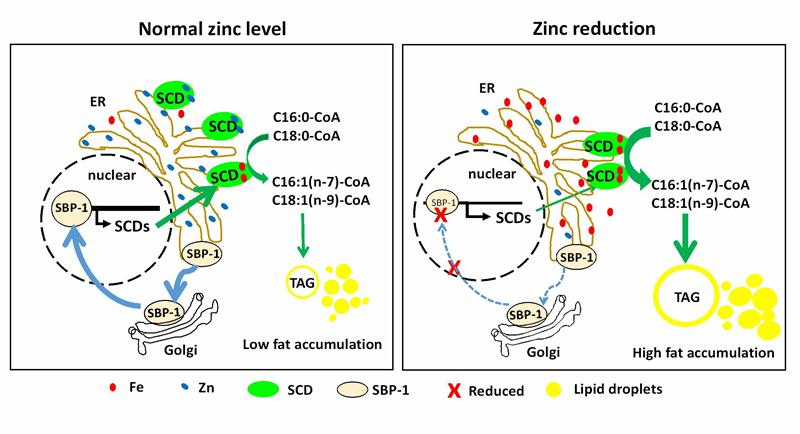Recently, cooperating with Guangzhou Medical University, Kunming Institute of Zoology reveals a distinct regulatory circuit of SREBP-SCD in regulating lipid metabolism in worm. The study was published inJournal of Lipid Researchhttp://www.jlr.org/content/early/2017/07/14/jlr.M077198.long.
Lipids, including fatty acids, triglycerides and cholesterol, are important membrane components, signaling molecules, and energy reservoirs. To grow, proliferate and survive, the cell must evolve certain mechanisms to quickly respond to lipid requirements or surplus. The transcription factors sterol regulatory element binding proteins (SREBPs) play essential roles to regulate the biosynthesis of fatty acids, triglycerides, and cholesterol to meet the needs of the cell.
In mammals, SREBPs are encoded by two genes,SREBF-1andSREBF-2.SREBF-1is transcribed by alternative promoter usage into two isoforms,SREBP-1aandSREBP-1c, of whichSREBP-1cmainly regulates fatty acid metabolism. SREBP-2 regulates the transcriptional expression of genes mostly participating in cholesterol metabolism. In spite of the above established regulatory circuits of SREBP-2 by cholesterol, SREBP-1 by PC, andDrosophiladSREBP by phosphatidylethanolamine (PE), it is still arguable that other unknown factors may participate in the SREBPs regulation of lipid metabolism.
The model organismC. eleganscontains only one SREBP family member encoded bysbp-1,which also regulates fatty acid, PC, and cholesterol metabolism. Through a forward genetic screen of suppressors ofsbp-1(ep79)mutant, Laboratory of Lipid and Diseases, led by Dr. LIANG Bin,found that reduction of SBP-1 surprisingly leads to high level of zinc.
On the contrary, zinc reduction by mutation ofsur-7,encoding a member of the cation diffusion facilitator (CDF) family, restores the fat accumulation and fatty acid profile ofsbp-1(ep79)mutant. Zinc reduction results in iron overload, which thereby directly activates the conversion activity of stearoyl-CoA desaturase (SCD), a main target of SREBP, to promote lipid biosynthesis and accumulation. However, zinc reduction reversely represses SBP-1 nuclear translocation, further down-regulates the transcription expression of SCD as for compensation.
Therefore, they reveal zinc-mediated regulation of the SREBP-SCD axis in lipid metabolism distinct from the negative regulation of SREBP-1 or SREBP-2 by PC or cholesterol, respectively, providing novel insights into the regulation of lipid homeostasis.
This worked was supported by the Strategic Priority Research Program of the Chinese Academy of Sciences, National Natural Science Foundation of China, and China Postdoctoral Science Foundation (2017M613018).

A working model of how zinc mediates SBP-1-SCD axis to regulate lipid metabolism (Image by LIANG Bin’s Group)
(By LIANG Bin, Editor: HE Linxi)
Contact:
LIANG Bin
liangb@mail.kiz.ac.cn

